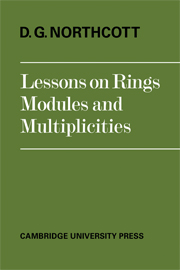Book contents
- Frontmatter
- Contents
- Preface
- Some notes for the reader
- 1 Introduction to some basic ideas
- 2 Prime ideals and primary submodules
- 3 Rings and modules of fractions
- 4 Noetherian rings and modules
- 5 The theory of grade
- 6 Hilbert rings and the Zeros Theorem
- 7 Multiplicity theory
- 8 The Koszul complex
- 9 Filtered rings and modules
- Index
9 - Filtered rings and modules
Published online by Cambridge University Press: 09 January 2010
- Frontmatter
- Contents
- Preface
- Some notes for the reader
- 1 Introduction to some basic ideas
- 2 Prime ideals and primary submodules
- 3 Rings and modules of fractions
- 4 Noetherian rings and modules
- 5 The theory of grade
- 6 Hilbert rings and the Zeros Theorem
- 7 Multiplicity theory
- 8 The Koszul complex
- 9 Filtered rings and modules
- Index
Summary
General remarks. As usual R denotes a ring with an identity element. The only section throughout which R is assumed to be commutative is (9.11). Wherever this assumption is not made, the term R-module should be interpreted as meaning left R-module.
A substantial part of the theory of commutative rings came into being through the study of local and semi-local rings, these being regarded as rings with a natural topology. In this context, the natural topologies arise from ideals. These investigations are now incorporated in a more general study which it is convenient to describe as the theory of rings and modules with filtrations. What follows is an introduction to this subject.
Topological prerequisites
It is assumed that the reader has some familiarity with the basic concepts of general topology. However, for his convenience, we recall briefly those that are relevant here.
A set U becomes endowed with a topology as soon as there is given a collection Ω of subsets of U having the following properties:
(a) both U and its empty subset belong to Ω;
(b) if {Oi}i ∈ Iis an arbitrary family of subsets of U such that each Oibelongs to Ω, then ∪i ∈ iOi also belongs to Ω;
(c) if O1, O2, …, On (n is an integer)belong to Ω, then O1∩O2 ∩ … ∩ Onbelongs to Ω as well.
The members of Ω are then referred to as the open sets of the topology and (a), (b), (c) are known as the open sets axioms. They can be summarized by saying that the class of open sets is closed under arbitrary unions and finite intersections.
Information
- Type
- Chapter
- Information
- Lessons on Rings, Modules and Multiplicities , pp. 377 - 440Publisher: Cambridge University PressPrint publication year: 1968
